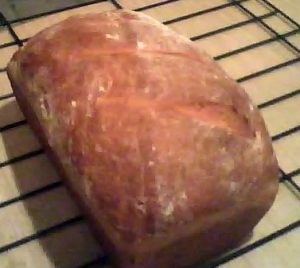This bread is simple, rich and tasty. This recipe is a Bachelor’s Kitchen exclusive specially designed for the non-baker. Use this to make 2 large (9×5″ pans) loaves or a 9×13 pan of dinner rolls. See tips in the footnotes. The olive oil can be replaced with regular vegetable oil or butter, but I like the tang of the EVOO.
About 36 generous servings. Prep time: 30-35 minutes; Baking time: 30-40 minutes; Rising time: 2 to 2-1/2 hours.
- 2 cups warm, 110-degree water
- 1 envelope (1/4 oz.) active dry yeast
- 8 cups flour
- 1/4 cup extra virgin olive oil
- 1/2 cup + 1 tablespoon sugar
- 2 eggs, beaten
- 2 teaspoons salt
- Pour the yeast and 1 tablespoon sugar into a large mixing bowl. Add the water (use a thermometer to get the temperature right). Stir well to dissolve. Allow the mixture to sit for about 10 minutes to proof yeast. A dirty-looking foam should form on the surface of the liquid. If it doesn’t, your yeast is dead and you need to start over with new yeast.
- Divide the flour into three groups: 4 cups, 3 cups and 1 cup to be used at different points.
- Heat oven to warm and place a shallow pan of about 2 cups of water on the bottom rack. After it reaches the lowest setting on your oven, turn it off.
- Stir in the rest of the sugar, eggs, salt and oil and mix well.
- Stir in 4 cups of flour and blend until all ingredients are incorporated into a very wet dough. Turn out onto a very well-floured countertop or firm, flat surface. Flour or oil your hands. The dough will be slightly sticky. Start kneading the dough adding half-cups of flour as needed until the dough forms a neat ball and is no longer sticky.
- Knead the dough, adding small amounts of flour, until it is no longer sticky and is smooth and elastic, about 6 to 10 minutes. It’s ready when a small amount of dough can be pinched off and spread like bubble gum thin enough to see through.
- Grease a clean mixing bowl and drop the dough ball into it. Turn the dough around inside the bowl until it is coated with oil. Cover with a damp towel and let sit in the cooled-down oven until it doubles in size, about an hour.
- About 30 minutes into this first rise, grab the sides of the dough and pull up onto the top of the ball all the way around. Recover and let the rise complete.
- When the dough has doubled in size, uncover and turn it out onto the floured surface again. Push the dough down until all air pockets are expelled. Shape roughly into a thick rectangle.
- Divide in half and place each piece into greased loaf pans. Re-wet the towel and cover the pans in a warm place. Allow it to rise again until doubled in size, about an hour.
- Use a sharp knife to cut diagonal slits in the top of each loaf. Turn the oven to 350F and allow it to reach full temperature. Refill water pan if needed.
- Bake bread for 30 to 40 minutes until tops are well browned. Remove to a wire rack for about 10 minutes. Carefully remove from pans and allow to cool on rack completely, about 30 minutes, before cutting. Serve with softened butter.
Tips:
- Warm tap water usually will work, but use a food thermometer to get the temperature right. You can vary by about 5 degrees on either side of 110F, but the closer the better.
- Honey can be used instead of sugar, but no artificial sweetener. This is food for the yeast.
- Use two large mixing bowls and two containers for flour to speed up the mixing process. Also, have a damp kitchen towel or hand towel nearby.
- For wheat or whole grain bread, mix the whole wheat or grain flour with unbleached white flour, about 50/50, before adding it to the mixing bowl.
- This recipe is developed for hand mixing. If you have a stand mixer with a dough hook, mixing and kneading time will be cut nearly in half. If you have a bread machine, use a recipe designed for that.
- Kneading should be more like folding the dough into itself, turning it around and over on your board.
- If making rolls, pinch off palm-size balls of dough and shape them into a ball, pulling the dough down and around the ball to get a smooth surface. Place next to each other in greased baking pan.
- If your kitchen is cold or drafty, place the rising dough in a slightly warm oven. Pre-heat the oven for a few minutes while you prepare to make the dough. Then turn it off and let it cool to about 100F if you have an oven thermometer. The water dish underneath the dough in oven is optional, but moisture makes a crispier crust.
- A bread knife is a good investment. It makes slicing the finished bread much easier. Non-serrated knives may cause bread to ball up during slicing.
